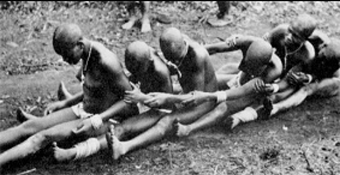| |
| |
Dadashanga - THE DUNG-BEETLE
The girls approach the ruler's courtyard as they sing thavha. After a few minutes, they sit on the ground, one behind the other, each with her legs stretched out on either side of the girl in front. They then move forward on their buttocks without touching the ground with their hands. Stayt (1931: 117-18) describes this only as ngoma mavhavhe, but does not mention the two rites which precede it, nor the explanation. As they move along the ground, the girls sing Domba Song No. 1. |
|

Novices move up into the courtyard on their buttocks. These were the first six girls to enter the 1957 domba at Thengwe. They were all nobles, and their hair had been shaved only the days previously, when they entered the school.
|
| |
Lesson
Just as the work of the dung-beetle requires effort and it is sore to move along on the buttocks, so girls must know that child-birth can be arduous and very painful. |
|
| |
Mulayo |
| 258 |
Vha tshi' "Dadashanga tshimbila nga  ": vha amba musadzi a tshi songwa: vha tshi songwa vha ": vha amba musadzi a tshi songwa: vha tshi songwa vha  ita hani? Vha ri ndi musi lukole lu khou bvuma: u nyaga u beba ita hani? Vha ri ndi musi lukole lu khou bvuma: u nyaga u beba  . Zwi a vhavha: zwi a naka vha tshi ita. . Zwi a vhavha: zwi a naka vha tshi ita.
When they say, "The dung-beetle walks with its back": they mean a woman when she has movements and rumblings in the stomach: when this happens, what will they do? They say it is the time when the small feathery cloud brings on the thunder: she wants to give birth to her baby. It burns with pain: but it is nice when it is all over [and she has a child]. |
| |
When the girls return to the council hut, they often do the rite Muleme. Since this is related to words in the domba song, it is described in the next section of the Website/CD-Rom. |
|
Video Clip
|
To return, click 'Back' in the browser.
|
Next
|
|